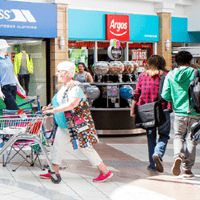Community shopping centres are an important asset class in their own right and there is good reason to believe that their offer, tuned to the local shopper, is more defensive than other kinds of retail location, given further challenges anticipated in consumer spending and the wider economy.
In this latest research, Savills have looked at the consumer perspective of the importance of local shopping journeys, with particular reference to Community shopping centres. We have analysed exit surveys from across Ellandi’s portfolio of shopping centres, to identify what it is that is driving these shopping trips.
Our research looks at how retailers whose shops are closely aligned with shopping centre locations, have evolved their portfolios with changing consumer preferences. We see how store numbers have grown significantly, or consolidated less dramatically in many sectors than was expected immediately following the Global Financial Crisis.
Our consumer insights show:
■ Travel is short (79% within 20 minutes)
■ Frequency is high (78% at least weekly); higher than regional malls, major high streets or online purchases
■ Dwell is surprisingly long (44% over one hour)
■ Basket spend averages £36.60 per visit
■ Demographic profile shows that the offer suits the needs of all consumer groups
■ Convenience key driver of visits (65%), yet highest basket spend is for other retail categories
■ F&B is not the ‘holy grail’ for all classes of shopping centre
Our retailer insights show:
■ Key sector brands have an average of 57% of their portfolio in the secondary market, with many core brands having +200 stores
■ The need for many retailers to have large portfolios inevitably means a strong reliance on more Secondary and Community shopping centre locations
■ Lower occupational costs mean stronger retailer affordability, profitability and sustainability
We also explore what makes a successful local shopping centre. A strong fit with the catchment is fundamental for any retail location, irrespective of their offer or catchment size. However, this is particularly pertinent to Community shopping centres. As these schemes draw from a very local catchment, meeting the functional, Convenience and Value needs of the everyday shopper is paramount.
Locations that have evolved supply to meet the cyclical and structural changes of the last decade should be the most adept at coping with future challenges. Furthermore, good management of local shopping schemes with a strong fit to catchment can see a marked improvement in footfall, void rates and retailer affordability.




.png)